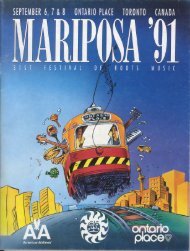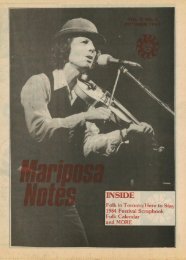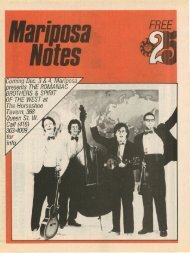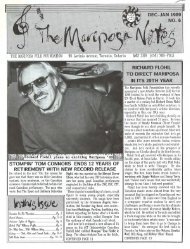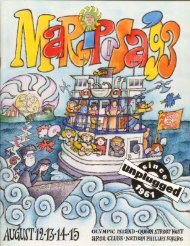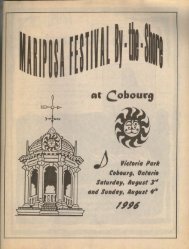Create successful ePaper yourself
Turn your PDF publications into a flip-book with our unique Google optimized e-Paper software.
SHARDA:<br />
A unique<br />
by Frank Pausch<br />
IN THE 16th CENTURY THE MOGHULS<br />
invaded northern India. They were lovers of<br />
the arts and it was in their courts and palaces<br />
the Persian, Arabian and lndian cultural<br />
synthesis took place - resulting in a style of<br />
northern Indian music (after almost two<br />
centuries of Moghul rule) that was distinctively<br />
different from that of the south.<br />
The first major court was built in Delhi,<br />
where the roots of bai, the oldest style of<br />
northern Indian music, can be traced.<br />
Lucknow was next to host a Moghul court.<br />
Sharda, one of <strong>Mariposa</strong>'s featured<br />
performers, has his family roots in Benares, a<br />
town to the south and east of Lucknow. Since<br />
they were musicians at the time, Sharda's<br />
ancestors sent representatives of their family<br />
to Lucknow to try and earn a place in the court.<br />
One was a child prodigy on the tabla (lndian<br />
drums), impressed all those who listened and<br />
was much in demand as a performer. As he<br />
grew, he also began to compose virtuoso tabla<br />
works popular to both inside and outside the<br />
courts. He had a special way of playing and of<br />
composing. These unique styles have been<br />
passed on orally from his generation to ours<br />
and are considered the "Benares<br />
As with any instrument, there are many<br />
levels of playing tabla, from the simplest folk<br />
tunes that can be learned in days or even<br />
hours, up to the most complex<br />
style". When<br />
you listen to Sharda's music, listen carefully,<br />
for those melodies, rhythms and instruments<br />
have existed, with little change, from the days<br />
of Moghul court life up until the present.<br />
Sharda's ancestors were not the only ones<br />
to develop their own style based on a master,<br />
During the Moghul rule, families from the<br />
same caste all over India sent artisans to the<br />
courts to try and gain prestige and earn their<br />
living. From this influx of talent rose other<br />
master musicians who also had their own<br />
style. The musicians did their best to please<br />
those who employed them, so styles tended to<br />
be somewhat different from court to court and<br />
from region to region.<br />
Over time and with the demise of the court<br />
system musical influence most styles died out<br />
or merged. The rise of radio and easier<br />
transportation greatly contributed to<br />
dissolving regional differences while the<br />
pressure to incorporate all styles into a<br />
homogenous whole increased as musicians<br />
tried to reach a wtder audience.<br />
There are now six major styles in existence,<br />
The first, as already mentioned, originated in<br />
Delhi. The second style is the Benares style.<br />
The most common, or at least the most<br />
listened to internationally, is the Pun.labi style<br />
which is what Ravi Shankar's son plays. This<br />
style originated in the area now called<br />
Pakistan. The form and function of the music<br />
itself can be compared in some respects, to<br />
Western jazz. In both kinds ot music, there are<br />
major forms and standard ways of performing<br />
them. In tabla music each composition<br />
presents a given amount of material. lt is up to<br />
the performer to present this material in the<br />
most interesting manner possible. Within the<br />
bounds of the piece, the artist can rearrange<br />
portions of it to suit his taste and technical<br />
ability.<br />
22<br />
"classical"<br />
works, comparable perhaps to Liszt's piano<br />
music. When an audience hears Sharda play, it<br />
is the height of Indian classical music they<br />
hear - something that takes a lifetime to<br />
practice and perfect.<br />
One common structure in north Indian tabla<br />
music is similar to our ballad form. A B A' B.<br />
where A can be considered a verse and B is the<br />
refrain.Themes can be introduced in the A<br />
section and in the A'section can be amplified<br />
and extended. The B section is a version of the<br />
theme in A. How the theme is added to and<br />
changed is up to the performer, but there are<br />
strict guidelines to this. In big band jazz, a<br />
Derson can solo for a certain number of bars<br />
and then return to the main body of music. lt is<br />
the same with tabla music - the oerformer<br />
can "spontaneously<br />
compose" (to quote Bob<br />
performance practice is that the player never<br />
crosses hands; the left one always plays the<br />
baya, the right one uses the tabla.<br />
Sharda's concert at <strong>Mariposa</strong> this year is a<br />
must for aficionados of rhythm and melody.<br />
Do not be intimidated, for there is much in<br />
common with Western music. Although there<br />
is no functional harmony, the beat is strong<br />
and constant, and much of the material is<br />
repeated at some point. A common rhythmic<br />
form to listen for is the taki, which is usually an<br />
ending cadence. lt is a phrase repeated three<br />
times with a gap between each phrase. A good<br />
taki is the mark of a good player, for it always<br />
ends on a downbeat, whtch means it has to be<br />
prepared well in advance of the actual end ot<br />
the piece. So listen and enjoy!<br />
(Special thanks to Bob Becker for his<br />
i nval u able assistance.,)<br />
Becker) on a certain theme for so many beats<br />
before returning to the unaltered theme or<br />
themes can be repeated any number of times,<br />
so that one piece of music can last for qurte a<br />
while. The ability to rearrange the material to<br />
develop a theme, without adding new material,<br />
is a necessary requisite for any competent<br />
tabla player.<br />
Each composition is made up of a certain<br />
beat pattern that is repeated throughout the<br />
piece. This is similar to, say, a twelve-bar blues<br />
which repeats every twelve bars. The<br />
rhythmic/melodic pattern ranges from six to<br />
sixteen beats. These patterns are called tala, or<br />
lal (singular). Tala are used in virtually alltabla<br />
music, with regional or family differences.<br />
The actual tal cycle is fairly slow, even<br />
though rhythmic embellishments can be<br />
amazingly fast. This makes the lahara or<br />
melody very important. lt is normally played<br />
on the sarangi, an Indian strrnged instrument,<br />
or on a violin. For Sharda's concert at<br />
<strong>Mariposa</strong>, Bob Becker, of Nexus fame, will<br />
play the lahara on harmonium. The lahara is<br />
the exact length of the tal cycle, repeated<br />
without alterations throughout the entire<br />
piece. Although the tabla player is the one to<br />
listen to, the lahara's rise and fall serves as a<br />
reference point by which the audience can<br />
determine where the per{ormers are in the<br />
cycle. The other per{ormer on the stage is the<br />
tamboura player who playes the drone notes<br />
which are unchanging and constant.<br />
The drums themselves can be considered<br />
woi'ks of art, without even being played. The<br />
right hand drum is called the tabla and the leit<br />
hand drum is the baya. These drums are not<br />
like the Western instruments, for they are used<br />
both melodically and rhythmically. Notice the<br />
black oatch on each drum head. This is<br />
actually a small packet with some heavy<br />
material, like iron powder, used to lower the<br />
oitch of the drum and tune the overtones. lt is<br />
permanently attached to the tabla, but on the<br />
baya it is sometimes put in different spots,<br />
depending on the situation. An interesting<br />
I,YASN'T<br />
THAT<br />
A TIIYIE!<br />
FOLK MUSIC MEANS TO ME<br />
people having a good time playing<br />
music together. To me, <strong>Mariposa</strong><br />
meant a chance to see singers,<br />
musicians, dancers and craftspeople<br />
who learned their skills from<br />
friends and relatives,<br />
"in<br />
the good old<br />
way." The festival inspired and<br />
encouraged as well as entertained -<br />
so people would want to be where<br />
music was being made for fun, and<br />
maybe even to make some themselves.<br />
So we looked for performers<br />
who reached the heart and mind as<br />
well as the feet. We wanted the best,<br />
old and new, not the most. We<br />
weren't trying for standing ovations;<br />
we were trying to get people to think,<br />
"Maybe<br />
I could play like that," and,<br />
"Boy,<br />
that was fun!" As a performer, I<br />
want listeners to feel what I felt when<br />
I first heard the songs; as an<br />
organizer I want festival-goers to feel<br />
the excitement, magic and inspiration<br />
that I first felt at festivals, 25<br />
years ago. <strong>Mariposa</strong> did it for me - |<br />
try to pass it on.<br />
by MICHAEL COONEY



